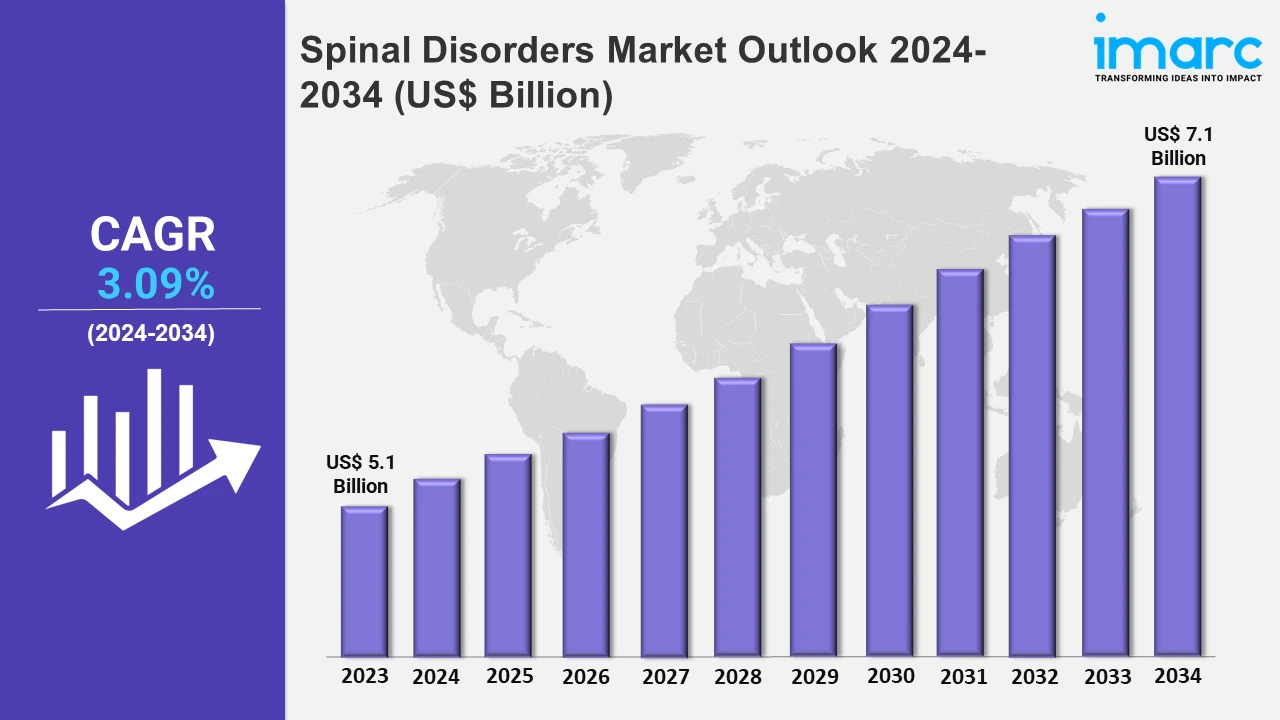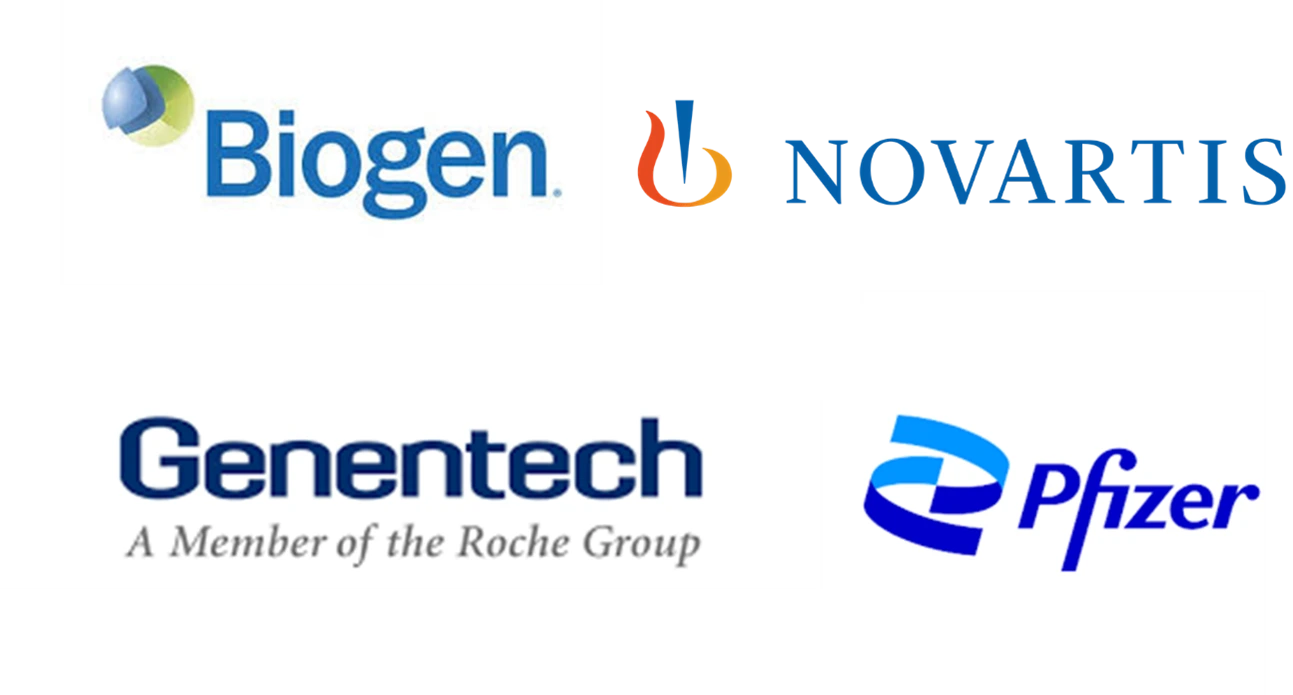Spinal Disorders Market Size to Reach US$ 7.1 Billion by 2034, Impelled by Advancements in Early Detection
Spinal Disorders Market Outlook 2024-2034:
The spinal disorders market size reached a value of US$ 5.1 Billion in 2023. Looking forward, the market is expected to reach US$ 7.1 Billion by 2034, exhibiting a growth rate (CAGR) of 3.09% during 2024-2034. The market is driven by the escalating utilization of novel interventions, including platelet-rich plasma injections and stem cell therapy, to promote tissue healing and stimulate tissue regeneration.

To get more information on this market, Request Sample
Advances in Early Detection and Diagnostic Technologies: Driving the Spinal Disorders Market
Advances in early detection and diagnostic technologies are significantly driving the growth of the spinal disorders market, enabling more precise diagnosis and tailored treatment strategies. Moreover, imaging technologies remain at the forefront of spinal disorder diagnostics. High-resolution magnetic resonance imaging (MRI) and computed tomography (CT) scans have become standard for visualizing the spine’s complex structures. Advanced techniques such as diffusion tensor imaging (DTI) and functional MRI (fMRI) offer detailed insights into nerve and spinal cord function, enhancing the ability to detect subtle abnormalities. These technologies provide a comprehensive understanding of the extent of spinal damage, which is crucial for planning surgical or non-surgical interventions. Furthermore, biomarker research is also emerging as a promising area for early detection. Novel biomarkers detected in blood, cerebrospinal fluid, or imaging studies can indicate inflammatory or degenerative processes, offering non-invasive methods to diagnose conditions like spinal arthritis or degenerative disc disease. Besides this, the integration of telemedicine and wearable technologies is expanding access to diagnostics. Remote monitoring devices can track posture, spinal motion, and pain levels, providing real-time data to clinicians. These advancements not only improve patient outcomes by enabling earlier and more precise interventions but also drive demand for diagnostic tools, propelling the spinal disorders market forward.
Development of Novel Therapies and Pharmacological Treatments: Contributing to Market Expansion
The development of novel therapies and pharmacological treatments is significantly contributing to the expansion of the spinal disorders market, addressing unmet medical needs and improving patient outcomes. Traditional treatments, such as physical therapy, pain management, and surgery, often provide limited relief or involve significant risks, driving the demand for innovative therapeutic solutions. One of the most promising areas of innovation is regenerative medicine. Stem cell therapies and platelet-rich plasma (PRP) treatments are being developed to repair damaged spinal discs and tissues by promoting regeneration and reducing inflammation. These minimally invasive approaches have shown the potential to slow disease progression and restore function, offering an alternative to surgery for many patients. Additionally, biologic therapies, such as growth factors and cytokine modulators, are emerging as targeted solutions for inflammation and tissue repair in spinal conditions. These therapies address the underlying causes of pain and degeneration rather than merely masking symptoms, leading to more effective and lasting results. Furthermore, advancements in pharmacological treatments are expanding the therapeutic arsenal for spinal disorders. Non-opioid pain relief options, including selective nerve blockers and neuromodulators, are gaining traction, reducing dependency on addictive medications. Additionally, small-molecule inhibitors targeting specific pathways involved in inflammation and degeneration are under development, providing personalized treatment options. Besides this, the integration of technology in spinal therapies, such as drug delivery systems and spinal implants embedded with bioactive substances, is further enhancing outcomes.
Marketed Therapies in Spinal Disorders Market
Lyrica (Pregabalin): Pfizer
Lyrica (Pregabalin) is indicated for the management of neuropathic pain associated with spinal cord injury. The drug controls the release of various excitatory neurotransmitters in the central nervous system by binding presynaptically to the alpha2-delta subunit of voltage-gated calcium channels. These neurotransmitters include glutamate, substance-P, norepinephrine, and calcitonin gene related peptide. Furthermore, pregabalin inhibits the trafficking of the alpha2-delta subunit from the dorsal root ganglia to the spinal dorsal horn, which may contribute to the mechanism of action.
Spinraza (Nusinersen): Biogen
Spinraza (Nusinersen) is a medication used to treat spinal muscular atrophy in pediatric and adult patients. Nusinersen is a survival motor neuron-2 (SMN2)-directed antisense oligonucleotide (ASO) intended to treat SMA caused by chromosome 5q mutations that result in SMN protein deficiency. Nusinersen replaces the SMN protein deficiency that causes SMA by boosting the splicing efficiency of the SMN2 pre-messenger ribonucleic acid (mRNA). More specifically, nusinersen is an 18-mer 2'-MOE phosphorothioate antisense oligonucleotide that works as a splice-altering oligonucleotide.
Evrysdi (Risdiplam): Genentech
Evrysdi is a prescription medication used to treat spinal muscular atrophy (SMA) in both children and adults. Evrysdi is an mRNA splicing modifier for SMN2 that promotes the inclusion of exon 7 during splicing, increasing the amount of functional SMN protein generated by SMN2. It does this by binding to two locations in SMN2 pre-mRNA: the 5' splice site (5'ss) of intron 7, and the exonic splicing enhancer 2 (ESE2) of exon 7.
Zolgensma (Onasemnogene Abeparvovec-Xioi): Novartis Gene Therapies
Zolgensma (Onasemnogene Abeparvovec-Xioi) is a gene therapy that treats neonates and infants with spinal muscular atrophy caused by bi-allelic mutations in the survival motor neuron 1 (SMN1) gene. Onasemnogene abeparvovec is a recombinant self-complementary adeno-associated virus serotype 9 (AAV9) gene delivery vector that incorporates a transgene encoding the human SMN protein. AAV9 is widely employed in gene therapy applications because it can cross the blood-brain barrier and transduce neurons in the CNS. After delivery, the viral vector is shed, and a copy of the gene encoding the human SMN protein is supplied, resulting in cell transduction and SMN protein expression.
Leading Companies in the Spinal Disorders Market:
The market research report by IMARC encompasses a comprehensive analysis of the competitive landscape in the market. Across the global spinal disorders market, several leading companies are at the forefront of developing integrated platforms to enhance the management of spinal disorders. Some of the major players include Biogen, Genentech, and Novartis Gene Therapies. These companies are driving innovation in the spinal disorders market through continuous research, diagnostic tools, and expanding their product offerings to meet the growing demand for the illness.
In September 2024, Biogen Inc. reported beneficial topline data from the pivotal cohort (Part B) of the Phase 2/3 DEVOTE trial, which assessed the safety and effectiveness of a higher dose regimen of nusinersen in treatment-naïve, symptomatic infants with SMA. In comparison to the approved nusinersen regimen (SPINRAZA), the exploratory higher dose regimen includes a more rapid loading regimen of two 50 mg doses 14 days apart, as well as a higher maintenance regimen of 28 mg every four months. The trial attained its primary aim at six months, with infants receiving the higher dose regimen showing statistically significant improvement in motor function when compared to a prespecified matched sham (untreated) control group from the ENDEAR study.
In June 2024, Genentech released its new 5-year data from the open-label extension of the pivotal FIREFISH trial, which confirms Evrysdi's (risdiplam) maintained efficacy and safety profile in children with Type 1 spinal muscular atrophy. By the end of year 5, 91% of children treated with Evrysdi were alive, 81% survived without permanent ventilation, and the majority (59%) could sit without assistance for at least 30 seconds. At the end of year 5, seven students could stand, three with assistance, four independently, and six could walk with support.
In March 2024, Novartis provided new results that support the clinical efficacy of Zolgensma (onasemnogene abeparvovec), the only one-time gene therapy for spinal muscular atrophy. The SMART research found Zolgensma to be safe and effective in children with spinal muscular atrophy weighing > 8.5 kg to ≤ 21 kg, with a mean age of 4.69 years.
Key Players in Spinal Disorders Market:
The key players in the Spinal Disorders market who are in different phases of developing different therapies are Pfizer, Biogen, Genentech, Novartis Gene Therapies, and Others.

Regional Analysis:
The major markets for spinal disorders include the United States, Germany, France, the United Kingdom, Italy, Spain, and Japan. According to projections by IMARC, the United States has the largest patient pool for spinal disorders while also representing the biggest market for its treatment. This can be attributed to the growing aging population, who are more susceptible to spinal degeneration and related disorders.
Moreover, the rising application of high-resolution imaging modalities, such as MRI and CT scans, enables earlier and more accurate diagnosis, leading to timely treatment and improved outcomes. Additionally, minimally invasive surgical techniques, such as robotic-assisted procedures and endoscopic spine surgeries, are gaining popularity for their ability to reduce recovery times and complications.
Besides this, non-surgical treatments, including regenerative therapies like stem cell applications and advanced biologics, are also contributing to market growth. Increased awareness of non-opioid pain management options, driven by the U.S. opioid crisis, has further highlighted the need for innovative spinal therapies.
Key information covered in the report.
- Base Year: 2023
- Historical Period: 2018-2023
- Market Forecast: 2024-2034
Countries Covered
- United States
- Germany
- France
- United Kingdom
- Italy
- Spain
- Japan
Analysis Covered Across Each Country
- Historical, current, and future epidemiology scenario
- Historical, current, and future performance of the spinal disorders market
- Historical, current, and future performance of various therapeutic categories in the market
- Sales of various drugs across the spinal disorders market
- Reimbursement scenario in the market
- In-market and pipeline drugs
Competitive Landscape:
This report offers a comprehensive analysis of current spinal disorders marketed drugs and late-stage pipeline drugs.
In-Market Drugs
- Drug Overview
- Mechanism of Action
- Regulatory Status
- Clinical Trial Results
- Drug Uptake and Market Performance
Late-Stage Pipeline Drugs
- Drug Overview
- Mechanism of Action
- Regulatory Status
- Clinical Trial Results
- Drug Uptake and Market Performance
About Us:
IMARC Group is a global management consulting firm that helps the world’s most ambitious changemakers to create a lasting impact. Across the six major continents and 100+ countries, we work alongside our business partners as one team with a common ambition to achieve unparallelled results, gain a competitive edge, and transform industries. IMARC Group excels in understanding its clients’ business priorities and delivering tailored solutions that drive meaningful outcomes. Our client base spans over 3,000 organizations in the private, public, and social sectors, ranging from high-growth startups to Fortune 500 companies.
Contact US
IMARC Group
134 N 4th St. Brooklyn, NY 11249, USA
Email: Sales@imarcgroup.com
Tel No:(D) +91 120 433 0800
Phone Number: - +1 631 791 1145, +91-120-433-0800
Need more help?
- Speak to our experienced analysts for insights on the current market scenarios.
- Include additional segments and countries to customize the report as per your requirement.
- Gain an unparalleled competitive advantage in your domain by understanding how to utilize the report and positively impacting your operations and revenue.
- For further assistance, please connect with our analysts.

 Inquire Before Buying
Inquire Before Buying
 Speak to an Analyst
Speak to an Analyst
 Request Brochure
Request Brochure




.webp)




.webp)












